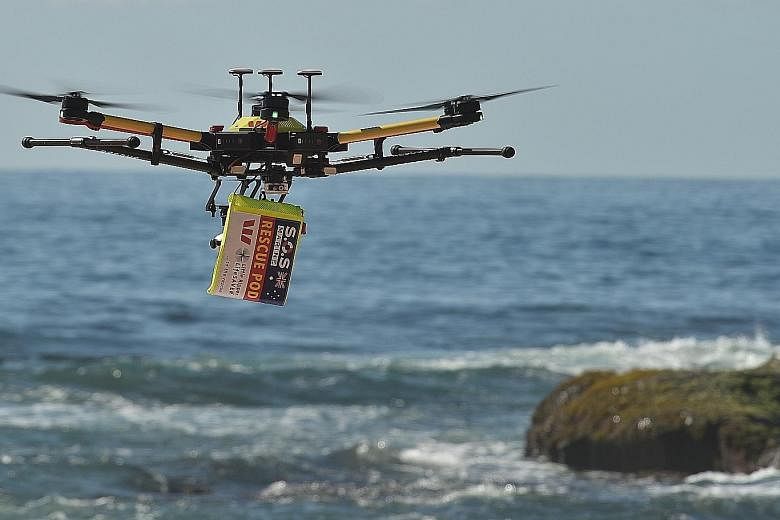On Wednesday morning, lifeguards at the popular Shelly Beach were monitoring footage beamed from a drone overhead when they spotted an ominous sight: a shark in waters dangerously close to shore.
Just last month at the same beach, a 1.5m shark attacked a 43-year-old surfer and left him with a 20cm bite on his leg. In 2015, a Japanese man was killed by a great white shark while surfing at the same beach.
So the authorities were not taking any chances after the drone detected the shark on Wednesday, which was Boxing Day, a popular day for beachgoers. They sounded sirens and also announced an evacuation via the New South Wales government's SharkSmart app and social media account.
"Shark sighted by a drone at Shelly Beach," said the announcement. "Beach is now closed."
Such procedures are becoming increasingly common. The evacuation of Shelly Beach, in northern New South Wales, was followed by the closure of two nearby beaches as sharks were spotted by a drone and an aerial patrol via helicopter.
Across the country, the authorities have deployed an unprecedented set of anti-shark measures to try to protect the hordes of holidaymakers and surfers flocking to the oceans this summer.
Aside from drones and helicopters, the state authorities have set up nets at beaches and installed offshore "smart" drumlines, which attach a baited hook to a buoy and alert the authorities when a shark has taken the bait. The shark can then be released or tagged with a device to allow it to be tracked.
-
400
More than this number of sharks of various species in New South Wales are being monitored via 21 underwater listening stations.
27
Number of shark attacks this year, including one death, according to the Australian Shark Attack File, compiled by Taronga Zoo.
1.5
Average number of deaths from shark attacks each year in the past three decades - higher than in previous decades. The Australian authorities do not know exactly why the number of shark attacks has risen, but it is believed to be due partly to more people entering the water. Australia's population has been increasing - and about 85 per cent of Australians live within 50km of the coast.
In New South Wales, Australia's most populous state, more than 400 sharks of various species are currently being monitored via 21 underwater listening stations - a surveillance programme that is believed to be the biggest in the world. The programme not only allows the authorities to alert beachgoers about the presence of dangerous sharks, but also enables scientists to gather valuable information about their movement patterns and behaviour.
Dr Geoff Allan, from the state's Department of Primary Industries, said the drumlines and tagging improve beach safety and reduce the impact on marine species.
"Through our shark-tagging programme, which is estimated to be the largest in the world, we are continuing to increase our scientists' knowledge about the movement and ecology of white, tiger and bull sharks," he said last week.
In Queensland, the state held an urgent summit following three recent attacks at Cid Harbour, a small stretch of water near the Great Barrier Reef. These included the death last month of a 33-year-old man from Melbourne who was attacked by a shark while swimming with friends off a yacht.
Following the summit, the state has begun researching shark behaviour in the region. It has also started a campaign to teach locals and tourists about shark safety.
According to the Australian Shark Attack File, compiled by Taronga Zoo, there have been 27 shark attacks this year, including one death. In the past three decades, there has been an average of 1.5 deaths from shark attacks each year - higher than in previous decades.
The Australian authorities do not know exactly why the number of shark attacks has risen, but it is believed to be due partly to more people entering the water. Australia's population has been increasing - and about 85 per cent of Australians live within 50km of the coast. In addition, there has been a rise in the number of tourists and backpackers, most of whom spend time at coastal cities and holiday spots.
Some researchers suggested that shark numbers may be going up, but recent groundbreaking research has disproved that theory.
Research released earlier this month by University of Queensland and Griffith University researchers found that shark populations appear to have declined dramatically over the past 55 years. The study found that the number of large sharks caught off the Queensland coast had declined by 74 to 92 per cent. It examined almost 50,000 instances of sharks being caught in official nets or by baited hooks.
"Increases in human-shark interactions are occurring at a time when shark populations are severely depleted compared to historical baselines," said the study published in journal Communications Biology.
Despite the relatively scant information on why and when sharks attack people, experts still believe that beachgoers can take safety precautions. These include avoiding murky waters or areas used by fishermen, or swimming with pets.
Swimmers are also advised to use beaches patrolled by lifeguards and to remain within the monitored areas, which are indicated by red and yellow flags on the beach.

